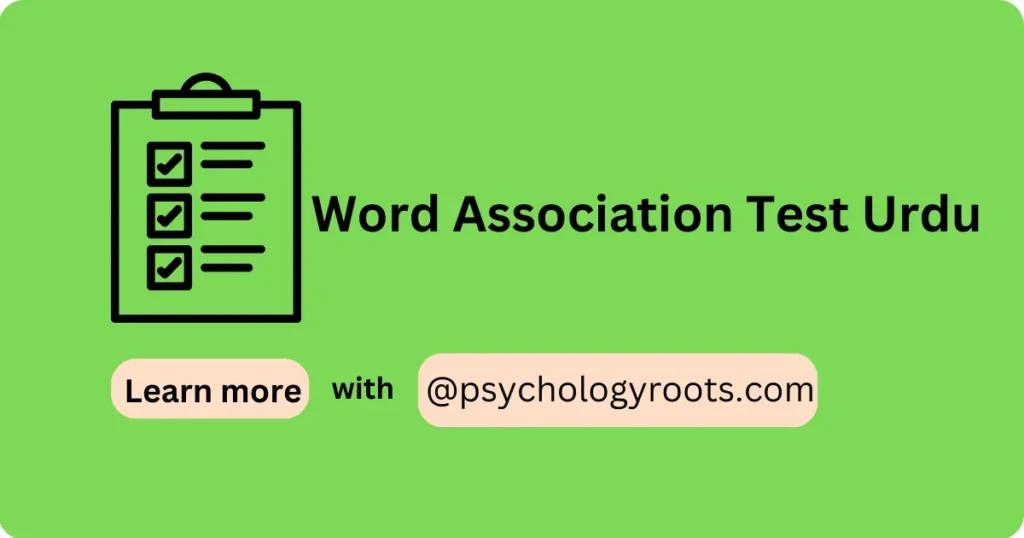Table of Contents
Word Association Test Urdu
Here in this post, we are sharing the “Word Association Test Urdu”. You can read psychometric and Author information. We have thousands of Scales and questionnaires in our collection (See Scales and Questionnaires). You can demand us any scale and questionnaires related to psychology through our community, and we will provide you with a short time. Keep visiting Psychology Roots.
About Word Association Test Urdu
Scale Name
Word Association Test Urdu
Author Details
Not Confirmed
Translation Availability
Not Sure

Background/Description
The Word Association Test (WAT) is a psychological tool that aims to reveal an individual’s thoughts, emotions, and attitudes through their responses to specific words. It is a projective technique, which means that it is designed to elicit spontaneous and unfiltered responses, providing insights into the person’s unconscious mind. The test is based on the idea that when people are presented with certain stimuli (in this case, words), their responses can provide clues about their underlying beliefs, experiences, and emotions.
The concept of word association has its roots in the work of Carl Gustav Jung and Sigmund Freud, two influential figures in the early development of psychology. However, it was primarily Carl Jung who formalized and popularized the Word Association Test as a tool for psychological analysis.
Here’s a brief overview of the Word Association Test and its background:
Carl Jung’s Contribution: Carl Jung, a Swiss psychiatrist and psychoanalyst, developed the Word Association Test as part of his work in analytical psychology.
Jung was a student of Sigmund Freud but later developed his own theories, emphasizing the importance of the collective unconscious and archetypes.
Purpose of the Test: The Word Association Test was designed to explore the unconscious aspects of an individual’s mind, revealing hidden thoughts and emotions that might not be accessible through conscious reflection.
Administration, Scoring and Interpretation
Preparing for the Test:
Selection of Stimulus Words: Choose a set of stimulus words that are neutral and cover a range of semantic categories. The goal is to trigger a variety of associations without being overly provocative.
Testing Environment:
Ensure a quiet and comfortable environment to minimize distractions and anxiety for the participant.
Informed Consent:
Explain the purpose of the test to the participant and obtain informed consent. Emphasize that there are no right or wrong answers.
Test Procedure:
Instructions: Clearly explain the instructions to the participant. Instruct them to respond with the first word that comes to mind upon seeing each stimulus word.
Encourage spontaneous and immediate responses.
Presentation of Stimulus Words: Present each stimulus word one at a time, allowing a brief moment for the participant to respond before moving on to the next word.
Record the participant’s responses verbatim.
Observation: Pay attention to non-verbal cues, such as hesitations, emotional expressions, or signs of discomfort.
Post-Test Procedures:
Debriefing: After completing the test, provide a debriefing session where you explain the nature of the test and address any questions or concerns the participant may have.
Confidentiality: Emphasize the confidentiality of the responses and how the information will be used (especially if it’s for research purposes).
Analysis:
Response Time: Note the time taken for each response. Faster responses are often associated with more spontaneous and less controlled thoughts.
Content Analysis: Analyze the content of the responses, looking for patterns, recurring themes, or unusual associations.
Emotional Tone: Consider the emotional tone of the responses. Emotional or charged words may indicate underlying emotional states.
Interpretation:
Context: Interpret responses in the context of the individual’s overall personality, experiences, and current emotional state.
Integration with Other Assessments: Consider integrating the findings from the Word Association Test with other assessment tools for a more comprehensive understanding.
Reliability and Validity
Not Conformed
Available Versions
100-Items
Reference
N/A
Important Link
Scale File:
Frequently Asked Questions
Q: What is the Word Association Test (WAT)?
A: A projective psychological test where individuals respond to stimulus words to reveal unconscious thoughts and emotions.
Q: Who developed the Word Association Test?
A: Carl Jung, a Swiss psychiatrist and psychoanalyst.
Q: What is the purpose of the WAT?
A: To explore the unconscious mind, identify patterns of association, and gain insights into personality and emotions.
Q: How is the WAT administered?
A: Participants respond to a series of stimulus words with the first word that comes to mind.
Q: Can the WAT be used for clinical assessment?
A: Yes, it’s used in clinical psychology to understand emotions, conflicts, and underlying personality traits.
Q: Are there cultural considerations in using the WAT?
A: Yes, cultural differences may influence responses, requiring sensitivity and adaptation of stimuli.
Q: What are some alternatives to the WAT in psychological assessments?
A: Rorschach Inkblot Test, Thematic Apperception Test (TAT), and other projective and objective measures.
Q: Is the WAT widely accepted in contemporary psychology?
A: It has faced criticism, and while still used, its popularity has decreased compared to more structured assessments.
Disclaimer
Please note that Psychology Roots does not have the right to grant permission for the use of any psychological scales or assessments listed on its website. To use any scale or assessment, you must obtain permission directly from the author or translator of the tool. Psychology Roots provides information about various tools and their administration procedures, but it is your responsibility to obtain proper permissions before using any scale or assessment. If you need further information about an author’s contact details, please submit a query to the Psychology Roots team.
Help Us Improve This Article
Have you discovered an inaccuracy? We put out great effort to give accurate and scientifically trustworthy information to our readers. Please notify us if you discover any typographical or grammatical errors.
Make a comment. We acknowledge and appreciate your efforts.
If you have any scale or any material related to psychology kindly share it with us at psychologyroots@gmail.com. We help others on behalf of you.